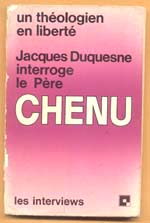The revolution in doctrine was an arduous work at Vatican II. It required meticulous planning and a careful distribution of functions.
This is confirmed by Fr. Chenu's words on how the ends of Catholic marriage were inverted in the conciliar documents. Fr. Marie-Dominique Chenu, one of the main inspirers of the adaptation of the Church to the modern world, reports his memories on this topic in the French book-interview A Theologian in Liberty - Jacques Duquesne questions Fr. Chenu [Un theologien en liberte - Jacques Duquesne interroge le Pere Chenu]
Top right is a reproduction of the book's cover ; at right, a photocopy of the French text. Below, we present our translation.
"Something significant took place when the text on the family of Gaudium et spes was writen. As you know, the 'traditional' thesis pretends that the primary end of marriage is reproduction with, secondarily, some small pleasures. The Council text, however, gave priority to love between the spouses, not to exclude procreation, but because it only acquires meaning inside of this love.
"On this topic, the Belgian periti notably played a great role. It was necessary to reformulate the traditional thesis on 'the two ends of matrimony' that came from St. Augustine.
"To change this terminology was a work for professionals in the field, for specialists. I can still remember entering St. Peter's Basilica one day and meeting a Belgian perito, who took me aside asking me to give a French Bishop the text of a new revision [regarding marriage] he had made, which I did. This was the way things worked."
(Marie-Dominique Chenu, Un theologian en liberte - Jacques Duquesne interroge le Pere Chenu, Paris: Centurion, 1975, pp. 17-18).
|


 |

Posted on September 17, 2005
|
